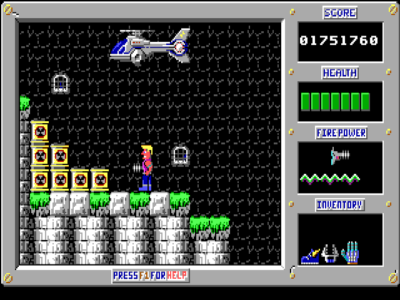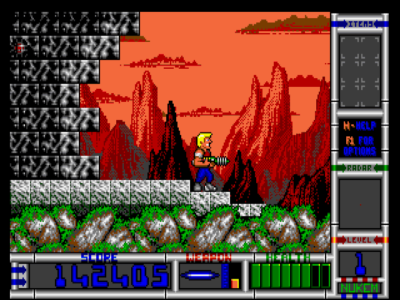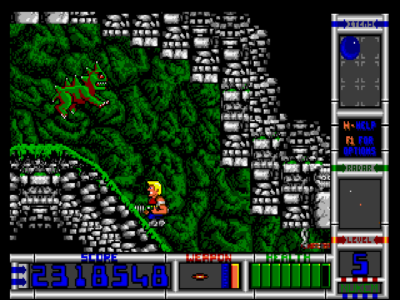
Duke Nukem 1 and 2
Written by: Stoo
Date posted: October 14, 2015
- Genre: Action
- Developed by: Apogee
- Published by: Apogee
- Year released: 1991
- Our score: 6
With his gravelly-voiced lines, muscles and, er, fondness for strip clubs, Duke Nukem remains one of the iconic heroes of gaming. He’s certainly one of the biggest names to have originated on the PC. We knew him for starring in one of the major first person shooters from the genre’s early days, Duke Nukem 3D. Then he became infamous for not actually starring in anything, because it took about fifteen years for a sequel to emerge. Which seemed to get an ambivalent response once finally released but at least Duke was back, rocket launcher in hand and spouting one-liners.
(I actually thought Duke Nukem Forever was a half-decent shooter that had paid attention to advances in the genre over the years of Duke’s absence. But that’s a discussion for another day).
Today though we’re going back to Duke’s origins. Before the first-person shooter days, he was the hero of pair of platform games. These were progammed by Todd Replogle and published by Apogee, back in the days before it became 3D Realms. They specialised in various action and arcade games and used the shareware model to give a large portion of each one away for free. They were one of the few major sources of original PC content of this kind; we often otherwise had to make do with lacklustre ports from other systems.
Duke Nukem 1 was released in July 1991. He had a bit of a different look those days, having not found his shades yet and also he wasn’t afraid to wear pink. I’m guessing that was thanks to the 16-colour limit of EGA graphics; red was had been used for his skin tones. Set in the near future, the game pits you against the robotic servants of Doctor Proton, chasing him across a devasted LA, then into the future. Or something. I probably should have read the token backstory jotted down in a text file somewhere.
It’s a platformer of the shooty kind, with Duke carrying a gun (of course) with limitless ammo. Most levels require you to find colour-coded keys that match doors blocking your progress. Levels aren’t particularly mentally taxing, although you do sometimes need to hunt around a bit to find the next key. Enemies include a little robot thing, and a more threatening ED-209 ish bot that leaps back and forth, quite possibly ending up on top of you.

DN1: unfortunately you can’t shoot upwards.
As traditional for an Apogee game there are stacks of points-items to pick up. They, weapons and health packs are placed in crates that you shoot to open. So are sticks of dynamite, just to keep you on your toes. Health powerups are lost if shot, which is actually a neat little feature that pushes you to be careful not to go blasting too wildly around red crates. Especially, while you have infinite lives, you seem to restart the level with only as much health as you came in with.
The elements that make up the action are all put together in a basically competent manner, I guess, but there are a bunch of limitations. You can only shoot shoot horizontally, which can be frustrating when up against flying foes. There’s no option to duck, either. Disappointingly, there’s no variety in weapons, except for upgrades to your rate of fire. Of the other powerups, the only one that adds a new dimension to the action is a claw that lets you hang from certain types of ceiling. Although it’s not used enough to be a key part of the inventory akin to, say, Commander Keen’s Pogo stick or the Bionic commando guy’s grapple.
Meanwhile the game’s graphics are a little blocky and basic. Sure we’re going back to 1991 here but Sonic the Hedgehog with his fancy parallax backdrops and super-fast scrolling happened around the same time. Meanwhile those smug gits with their Amigas already had Shadow of the Beast. The 16 colour limit doesn’t help, but Apogee stablemate Commander Keen: Goodbye Galaxy managed rather charming artwork with the same limitations. That said it’s sometimes colourful at least, and there’s a variety of style between levels. Some suggesting industry and technology, others more stone-themed. And one a series of weird bright green caves. I quite liked some later ones set in some sort of underground ruined city, with hints of more high tech structures visible through the gaps.
As for sound though, there isn’t much as sound cards weren’t supported. So all we get are a few bleeps and chirps from the basic PC speaker. Or a faithful DosBox reproduction of one. I was debating whether to cut the game some slack on this point; sound cards had only been a common part of a PC setup for a few years at that point.
So overall it’s a fairly humble, basic platformer. To be fair it’s perhaps what would we would expect of a small studio, developing for older hardware standards supported by most PCs of the time. Still I can’t imagine Amiga or Megadrive owners being jealous. Even fans of the NES, which at this point was looking fairly long in the tooth, might have remarked that at least they had music in their games.
However, an article expressing limited enthusiasm about a 24 year old game is sort of a pointless exercise and not really in keeping with the spirit of this site so, first up, let me say that for all these criticisms it’s still quite playable and it kept a dorky PC gamer like me happy for a few days back then. Also though, by changing from our usual posting setup and making this a double-game article, we can consider the progression between Duke and his sequel. Duke Nukem 2, released in 1993, improves on several aspects.

DN2: still EGA but the artwork does look a bit more refined.
For a start Duke is a more capable hero now, having figured out how to shoot vertically (instead of having to jump into the firing path of enemies overhead), and crouch to dodge incoming fire. There are new ways to move around the environments, with ladders and also ladders that he can hang from and swim along. His arsenal is more interesting too, since his basic gun can be upgraded to a laser that passes through solid walls and floors (shoot monsters from safety), a rocket launcher that has the greatest punch per shot, and a plasma gun with some unique tricks.
The intro makes use of the 256 colours of VGA. Which proves to be a bit misleading, as the game itself remains in EGA, but the artwork is of a higher quality this time around. Sprites are bigger, so our hero Duke looks a bit more impressive, and the square-blocks nature of the terrain isn’t always quite so obvious. The levels continue to come in a range of bright and vibrant styles – green caves, metallic labyrinths and my personal favourite , crumbling ruins under ominous fiery skies. Meanwhile cheerful midi music, of a style typical of later-era Apogee stuff, comes out of our speakers. Sure it’s a bit jangly and spongy but it gets you in the mood for some Duke-vs-alien action.
There are a bunch more features that help give the impression of a more developed and polished product, as if the original was the rough draft. The scenery itself can change, with stone blocks falling from the ceiling. Waypoints on each map let you restart from halfway through a level if you die. Then there are the spider-bots that cling to you, forcing you to jump around to shake them off. Irritating, sure, but it adds variety.
What’s also interesting here is how the tone of the series develops. The first game was totally straight faced about pitching a manly man hero against a mad scientist, which makes it feel a bit like an 80s kids’ cartoon. The sequel however has more of a sense of humour, and here Duke first gains his swaggering machismo. This starts with the intro, which briefly but shamelessly throws in references to both the Terminator and Lethal Weapon, and features Duke’s first ever spoken lines (sadly not yet voiced by Jon St John). We see him promoting his autobiography on a TV talk show strongly implied to be Oprah (!) before being captured by aliens because they need to harvest his brain. All subsequent bits of story text are basically just him flexing his muscles, saying something ridiculous and looking for the next fight.

DN2: I think I was crouching in the hope that thing would jump over me.
I don’t know if Duke 2 would be considered one of the top-tier platformers of the era; I can’t point to any aspect of it that’s truly exceptional. Also EGA graphics in 1993 were a slight disappointment. So if Duke had never gone 3D, this probably wouldn’t be an especially famous series and in the league of gaming heroes only us retro-fans would remember him. We’d probably rank him a bit behind Commander Keen – I reckon Goodbye Galaxy was Apogee’s single greatest platformer – and maybe ahead of the mullet guy from Bio Menace.
Still, this sequel did manage, more or less, to catch up with the competition. If not blowing away the 16-bit and Amiga platformers, it could stand alongside them with some self-respect, at least. It’s a pretty solid example of Apogee action, sometime we PC nerds could have for ourselves instead of hoping for a decent port from other systems, in the days before Doom and Duke 3D happened and we could be the smug ones for a while. Since you can get a third of it for free on Shareware, it’s certainly worth having at least a brief try today.


 Posts
Posts
I gotta say, from the screenshots I expected to drag through Duke 1 and enjoy Duke 2… and it ended up being completely opposite. I like my platformers, though I mostly played the console ones, and there’s one cardinal sin that kinda-sorta totally brings Duke 2 down: the camera is really amazingly bad. Instead of being mostly centered on Duke it only moves if you go near the edge of the screen which often results in him being hit, going into a trap or something else. I can’t for the life of me fathom why is it this bad since the camera was pretty good in Duke 1.
October 16, 2015 @ 3:22 am
Maybe? I took some pics to try and compare:
It looks like he’s about the same distance to the edge in both games, although in Duke2 the window with the actual game action is wider, so he’s still further from centre. Also he’s bigger which I guess makes the space around him relatively smaller.
October 19, 2015 @ 8:00 am
Or maybe it was a quirk of the initial Steam release that was tweaked (adding sunglasses to Duke) compared to the later release (that replaced it with the original version). I dunno. At any rate it was a shame because in all other areas Duke 2 blows the first one right outta the water.
October 19, 2015 @ 1:24 pm